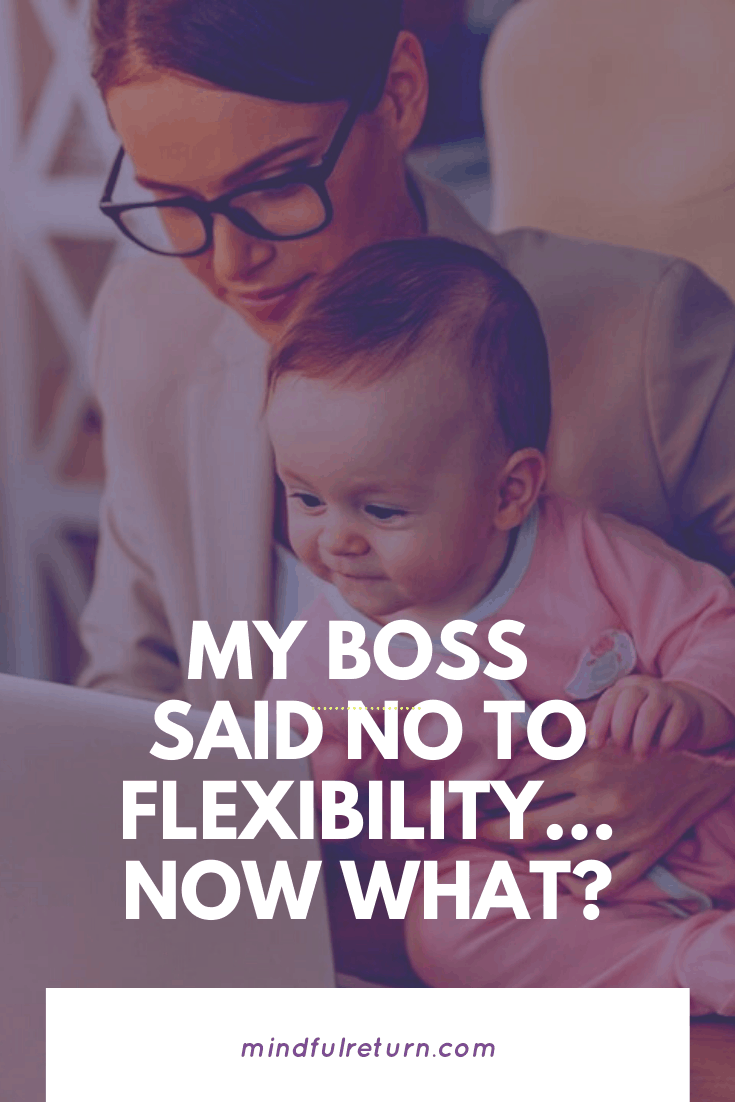 For as widespread as so-called “alternative” work arrangements are becoming, there are still hold-outs in the world of work flexibility. Over the past few weeks, I’ve had the opportunity to speak with several working parents whose good faith requests to accommodate variances to standard butt-in-chair work hours were met with rejection.
For as widespread as so-called “alternative” work arrangements are becoming, there are still hold-outs in the world of work flexibility. Over the past few weeks, I’ve had the opportunity to speak with several working parents whose good faith requests to accommodate variances to standard butt-in-chair work hours were met with rejection.
In one instance, this happened at an employer that had recently made great strides to improve its parental leave policy, in an effort to retain new parents. But what employers need to realize is that retaining new parents isn’t just about leave. Yes, that’s an important and great start. But retention is also about supporting the new parent during the transition back to work after parental leave. And it’s about offering ongoing opportunities for new parents to integrate life into work and work into life.
That’s where flexibility comes in.
Of course there are jobs that inherently don’t allow for much flexibility. We can all think of examples of jobs that require high levels of security clearance that require all work to be done on-site. Or of work that requires someone’s physical presence (e.g. fire fighter, anesthesiologist). I’d wager, however, that there may even be creative flexibility options for those types of jobs, if one thinks outside the box. And most jobs these days don’t fit that category.
What’s a Working Parent to Do If a Flexibility Request is Denied?
If you asked for some amount of flexibility and got shot down, I know you’re probably feeling defeated. Frustrated. Disappointed. And sad. When you’re doing your best to demonstrate you commitment to your job, orient yourself to parenthood, and quite frankly, simply survive, this can feel like a serious setback.
Here are my thoughts on options to explore:
- Know you’re not alone in wanting flexibility. More and more employees now cite a desire for more flexibility as a top reason for leaving their current role. Have empathy for yourself, and know it’s not that you are somehow “not good enough” for not being able to do your role within the confines of a schedule likely created by men with spouses at home.
- Benchmark your peer organizations. If you haven’t yet, it pays to ask around at other employers within your industry, to find out what they’re up to on the flexibility front. Not only will this give you data points you may be able to share with your current employer, but it will arm you with information about where the grass may in fact be greener, if you decide to jump ship.
- Consider appealing to your manager’s values and the commitments you share. If you’re going to take another stab at asking for what you need (remember that one “no” doesn’t always mean a forever “no”), try to look through your boss’s lens first. What does he most value? What motivates her? Is it a desire to be known as innovative? Or a commitment to efficiency? Whatever it is, you can probably find a way to frame your request in a way that aligns with and highlights their values. Emphasizing the commitments you both share (to high-quality work, for example), can also help you both get the conversation onto the same page.
- Acknowledge if they’ve been burned. Perhaps your manager had an experience with flexibility that didn’t go so well, and they felt taken advantage of. You can put this experience on the table and talk about practical ways your arrangement would be different. If you don’t know their past history with flexibility, now would be a good time to ask and learn more.
- Propose a trial period. A manager who may not be game to have you work from home two days a week for the rest of all time may be willing to do it for a month or two. Could your proposal build in a trial period with a defined evaluation at the end?
- Make the business case for flexibility. Numerous studies have documented the business advantages of flexible work cultures. See the resources from 1 Million for Work Flexibility. Also check out this great piece by the Diversity & Flexibility Alliance (DFA) entitled “Asking for Flex: It’s a Business Negotiation, Not a Personal Favor.”
- Consider the fairness factor. Managers may be afraid if they allow flexibility for you, they’ll open the floodgates to flexibility for everyone. To me this begs the question of whether the conversation is one that should be happening only with your manager, or with HR and other leaders at your organization as well. Who else should be brought into the conversation?
- If child illnesses are part of the struggle, inquire about back-up childcare options. Perhaps one of your challenges, particularly as a new parent, is dealing with the unexpected that comes with so many kid sick days. Flexibility can make the world of difference when a child is ill, daycare is closed, your nanny is on vacation, or the unexpected strikes. Employers willing to offer other generous benefits to employees in other areas may be willing to explore offering a back-up-care benefit (to get you back to work faster).
- Set your own boundaries around this negotiation. By necessity, working parents have huge amounts of resilience and grit. Consider applying those attributes here, and don’t give up after being told no once. Know that your fight for more flexibility may very well blaze the way for so many others. And yet. It’s somehow not fair that exhausted new parents who are struggling to get through the day need to be the ones spending time and energy leading the struggle for more flexibility. When it’s time to wave the white flag and move on, it’s time to move on.
- If you’ve reached the end of your own line, vote with your feet. You have skills, talents, and power in the marketplace. If you’ve tried, and tried, and things aren’t changing for the better, consider that there are many other employers out there who offer more flexibility and who would benefit from and appreciate what you bring to the table. I know it’s a decision not to take lightly. You do have options, though. I’d encourage you to be very clear on your way out about why you chose to leave, too.
To all those struggling for flexibility, I hear you. Technology permits us to work from anywhere, at any time. May our work habits and expectations one day catch up with that promise.
 If you need more help getting your head in a better place to return to work after maternity leave, join us for the next session of Mindful Return.
If you need more help getting your head in a better place to return to work after maternity leave, join us for the next session of Mindful Return.
Want more practical tips on working parenthood? Check out my book, Back to Work After Baby: How to Plan and Navigate a Mindful Return from Maternity Leave


